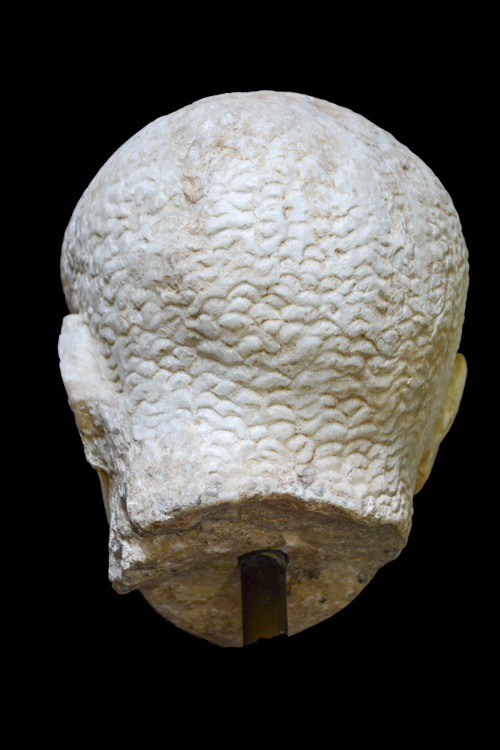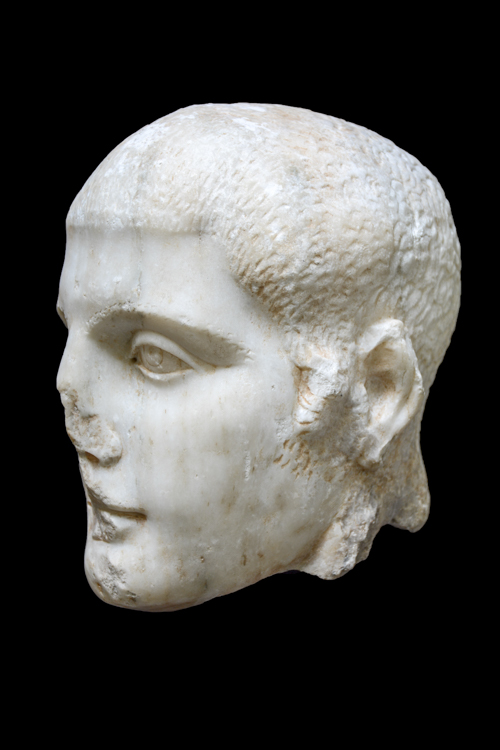Severan male portrait head
Category
HeadsAbout This Artefact
I.D. no: 35690
Dimensions: H. 23 cm; W. 17 cm
Material: Fine-grain white marble
Provenance: Unknown
Current location: National Museum of Archaeology
Condition: The head was broken at the neck, just below the chin, and restored in plaster before 1970 (Bonanno 1971: 151). It is preserved in relatively good condition, apart from a large ugly chip that has taken away most of the nose and both lips. Small chips are seen on the chin, forehead and right eyebrow; a larger chip on the left ear.
Description: The roundish, almost spherical, head belongs to a young man in his twenties. His clean-shaven face is characterized by a dimpled chin and a slight asymmetry in the eyes: the right eye and respective eyebrow are slightly higher than the left ones. The pupils and irises are incised and directed upwards while the sharply-edged eyebrows are rendered by shallow and short incisions. The lips were separated by a deep narrow furrow. The highly polished surfaces of the face contrast with the rough surface of the hair, rendered by short strokes of the chisel in a limited area above the forehead, while the rest forms a tight-fitting cap of short and shallow, stylized tufts around the skull and down the neck, taking up more volume at the whiskers.
Discussion: Its typology, style and technique place this portrait in the chronological span characterized by the portraiture of emperors Alexander Severus and Gordian III (AD 222-235; 238-244).[1] The solid and compact structure of the head and the simplified modelling of the face, the rendering of the hair and the asymmetry of the eyes are closely related to those of the portrait of a young man in Athens,[2] and another one in Fulda.[3]
Among the portraits of this period our head has major physiognomic and stylistic affinities in the portrait of a young man in the Museo Nazionale of Rome,[4] and another one in Istanbul (dated AD 220-230 or a little later, which is, however, rather fatter).[5] Another portrait of a young man from Side in Turkey wears similar thick and long side-whiskers and has similarly shaped and sharply cut eyes, but its short hair is modelled more naturalistically.[6]
The closest imperial portrait to our head is that of Alexander Severus in the Uffizi Gallery 198,[7] which has been assigned to the second iconographic type, that of Severus as Augustus,[8] even though, again, the hair is rather more plastically rendered and the bust wears a light beard under the chin. Some portraits attributed to Gordian III, however, offer very close iconographic and stylistic analogies as well.[9]
In its reaction against the baroque artistic tastes of the Antonine and Severan periods, which has produced a compact simplified modelling of the face and a low close-clipped hair-mass, and in its transcendental expression, the portrait anticipates the stereometry and the abstract and symbolic values which would establish themselves firmly in Roman portraiture by the end of the third century AD.
Date: second quarter of the third century AD.
Bibliography: (previous publications of item):
Caruana 1882: 114: ‘three heads, in marble, of Roman work, worthy of notice … are also preserved in the same collection’ [i.e. at the Public Library]; no specific mention of this head on p. 77 (see Ashby). Ashby 1915: 75-76, fig.30: ‘Male portrait head, 9 ins. high, of the third century AD. Hair hammered, eyebrows also hammered (rather in herring bone style), pupils rendered by incised circles, head much polished. Probably found in Malta: see Caruana, Report, p. 77’. Zammit 1919: 26. Sestieri 1936: 67-74. Bonanno 1971: 151-55. Bonanno 1992: pl. 40.
[1] Felletti Maj 1958: 83-103,147-156, pls. I-V, XVII-XX; Bergmann 1977: 26-29, pls. 2-5. Wegner 1971: 177-99, pls. 44-56; 1979: 13-29, pls. 1-9. See also Kersauson 1996: 416-21, 454-59.
[2] Sestieri 1936: 73-74 (previous bibliography cited in note 19), fig.4. See also Lattanzi 1968: 58-59, no.26, pl. 26a-b.
[3] Von Heintze 1968: 77, no. 51, pls. 84-85 (AD 250-260); Balty and Balty 1976: 179-180; pls. 43,1; 44,1; 46,1 (‘Herennius Etruscus’).
[4] Felletti Maj 1953: 145-146, no 290.
[5] Inan-Rosenbaum 1966: 97, no 85, pl. LII, 1-2 (‘linked by its coiffure with portraits of Gordianus III as Augustus’).
[6] Inan-Alföldi-Rosenbaum 1979: 261-262, no 244, pls. 173, 174, 3. The head belongs to the male reclining figure on a sarcophagus lid in the museum of Side.
[7] Mansuelli 1961: 116-117, no 147.; Saletti 1967: 74-77, pls. XXVI-XXVIII.
[8] Felletti Maj 1958: 92-95, especially 93, no 18, pl. II, 10; Saletti ibid.; Wegner 1971: 182, 186-187, pls. 53, 65a (‘Type 4’). Fittschen and Zanker (1985: no 99) reduce the prototypes of the portraits of this emperor to four.
[9] Felletti Maj 1958: 147-163, especially nos. 149, 162, 163, pls. XVII-XXI.




